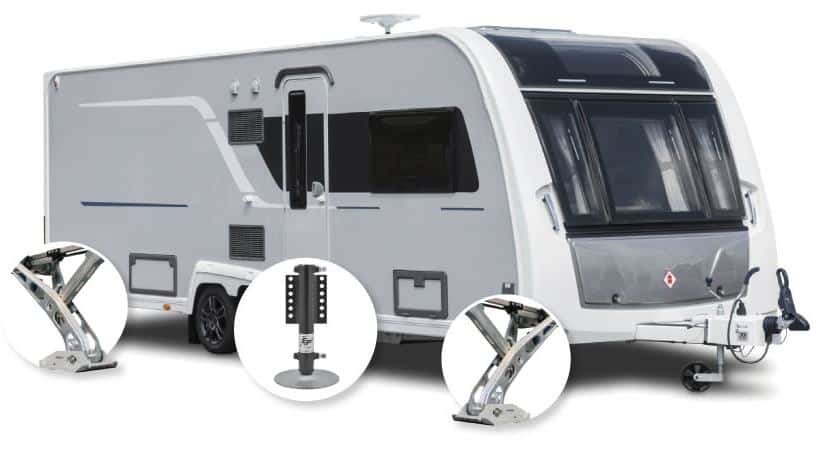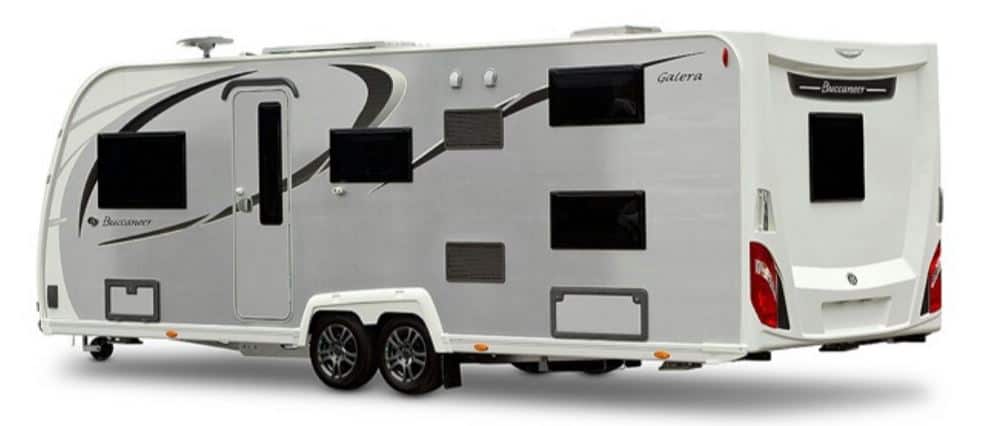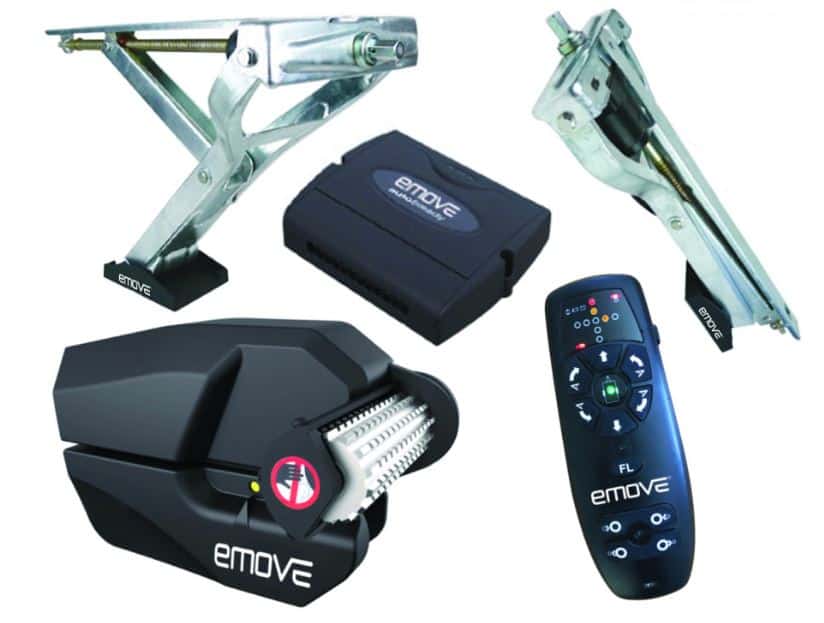
I’ve previously written posts on how to level a caravan and motorhome. In those posts, I briefly touched on the topic of self-levelling caravan devices. However, with this post, I wanted to discuss them in a bit more detail. For instance, what are the different types of caravan self-levelling devices, who they are really suitable for and, of course price. When it comes to price, a self-levelling system can be a significant investment, especially for a hydraulic system. However, for those with disabilities, the value of self-levelling is priceless. So let’s discuss the various self-levelling options in more detail.

There are two types of systems available to level a caravan. The hydraulic-based systems and motor mover based systems.
Below, I’ll discuss the two different systems. However, please note both systems use your leisure battery for power.
While the hydraulic self-levelling systems use pressurized oil to do the work of lifting the caravan, there is a hydraulic pump that has to be powered by your leisure battery.
Therefore, if you are considering either of the two caravan self-levelling systems below, you need a caravan leisure battery that’s in good health and really at least 80ah, ideally 100ah plus.
You can use the Table of Contents below to jump to any particular section if you don’t have the time to read this whole post. Enjoy 🙂
Disclaimer: Hey! By the way… any links on this page that lead to products on Amazon or Caravan Guard are affiliate links, and I earn a commission if you make a purchase, with no additional cost to you 🙂
- Dissolves waste and removes odours naturally and has delightful mild fragrance
Want To Visit Horton Common? – Book Here
Table of Contents
Hydraulic Automated Caravan Self-Levelling Devices
As of writing this post, the only manufacturer of hydraulic self-levelling systems for caravans is a company called E&P Hydraulics.
They are based in Blackburn and have been working on their caravan self-levelling systems since 2007.
While you can purchase E&P Hydraulics self-levelling systems as a retrofit for most caravans, there are (were) certain caravan models which came with this feature fitted from the factory.
As you probably guessed, these were ‘premium’ models. They included the Buccaneer Galera, and the Lunar Alaria.

How Does a Hydraulic Self-Levelling System Work?
With simply the push of one button on the remote control, the E&P Hydraulics self-levelling system would get the caravan level in under 2 minutes.
Two large hydraulic feet are bolted to the caravan axle. The system provides 170 bar of hydraulic pressure to the feet to lift the caravan.
Now the ‘Compact’ kit includes just the two main hydraulic lifts on the axle. However, they also offer a ‘Complete’ system.
The Complete system also features four hydraulically activated AL-KO premium corner steadies.
So, once the two main hydraulic jacks have lifted the caravan axle level, the corner steadies, then level the caravan front to back.
A couple of years before the Buccaneer Galera was launched, Practical Caravan did an interview with E&P Hydraulics on the benefits of their system and who their target customers are:
With their self-levelling system, E&P Hydraulics wants to emphasise that you no longer need to use blocks and levelling ramps etc. However, I would like to quickly note that’s not exactly accurate.
The system works with two hydraulic feet located on either side of the axle. Yes, the feet do have a relatively wide footprint compared to say, the caravan corner steadies.
However, remember, these hydraulic feet are lifting the whole van on their own.
While our site has hardstanding pitches, if you are visiting a site with only grass pitches and there has been a lot of rain, you would still need boards to hand to displace the load under those hydraulic feet.
Otherwise, those hydraulic feet will sink into the ground instead of lifting the caravan.
A benefit of the system, as discussed in the video, would be changing a wheel at the side of the road. I agree, this system would make that a lot easier.
However, if your leisure battery failed or was flat, you couldn’t depend on that feature. Therefore, its still recommended to carry a caravan jack to replace a flat tyre.
Overwinter Storage & Security
Now, caravan tyres don’t last forever despite there often being plenty of tread left on them, which I’ve previously discussed in this post.
When caravan tyres experience a particularly tough time is during storage over winter. If the weight of the caravan is left on the tyres, you can get flat spots on the tyre and sidewall cracking.
E&P Hydraulics state that with their system, the caravan can be left in storage with the tyres completely off the ground. This is true and is a benefit of their system.
However, an experienced caravanner could obviously use either tyre savers or support the caravan on axle stands for the same effect.
I remember reading some articles several years ago that emphasised the security benefits of the E&P Hydraulics self-levelling system.
The point is that once the hydraulic legs and jack are down, they cannot be lifted without the remote control.
I thought I’d look into this claim a bit more, and I thought, ‘well, what if your leisure battery fails, you’re stuck!‘. The reality is the system has an emergency retract button.
Once hooked up to your car’s 12V battery, you can get the legs/jacks to retract. Granted, a potential thief is highly unlikely to know this.
But still, in terms of caravan security, I would still stick to hitch locks, wheel clamps and potentially leg logs.
Disabilities & Physical Limitations
As discussed by the E&P Hydraulics representative in the video, probably the most viable use for this technology is for disabled caravanners and those with physical limitations.
Our guests to Horton Common that have had such systems on their caravan or motorhome, physical limitations were the reason they chose to go with a self-levelling system.
The simple reason being it meant they could keep caravanning. Now, that’s not to say everyone else would not enjoy the benefits of such devices. However, there are downsides….
Impact On Caravan Payload
If you were to consider a retrofit of a hydraulic self-levelling system from E&P to your caravan, there is something very important you need to consider.
A self-levelling system will impact the payload of your caravan, the noseweight and thus, how you load your caravan.
The Buccaneer Galera is a big twin-axle caravan with an MTPLM of 2,000kg and a user payload of 159kg. However, if you have a single-axle caravan, your user payload will be more significantly affected.
E&P states their system will deduct between 28-30kg from the caravans user payload depending on if you have the Compact or Complete set up with the hydraulic corner steadies.
Now, most of our guests also have a caravan motor mover. A motor mover will also reduce your payload by typically 30kg.
Therefore with a hydraulic self-levelling system and motor mover, you have lost around 60kg of your user payload!
Its always surprising when loading a caravan how much weight your belongings can add. Therefore, if you don’t have a large car to store your belongings, unless you travel light, adding a hydraulic levelling system could cause you problems keeping under the MTPLM weight of your caravan.
The Cost Of Hydraulic Caravan Self-Levelling Systems
So there are acknowledged benefits to this self-levelling system, particularly for disabled caravaners and those with physical limitations.
If you really want a Buccaneer Galera, its a great system to have included, however, when it comes to retrofitting, the cost is pretty significant.
So if you went for the Compact system (no hydraulic corner steadies), you’re looking at around £1,800. If you want the Complete kit, that’s going to cost you around £3,000.
The installation process apparently takes around 4 hours. By most ‘normal’ people’s definition, that’s a pretty significant amount of money.
Therefore, you would really have to consider if such a system would be of sufficient benefit to you. However, there is another option you could consider for an automated self-levelling caravan system…
Motor Mover Based Automated Caravan Self-Levelling System
There is another alternative to a hydraulic caravan automated self-levelling system, and that is a motor mover based system.
Emove is currently the only motor mover brand to offer such a system. However, I would expect several other motor mover manufacturers to be offering a similar product within the coming years.
I have briefly discussed the Emove ‘Finding Level’ system in a very long post on caravan motor movers.
However, I wanted to discuss it in a bit more detail in this post and in comparison to the hydraulic self-levelling system.
How Does a Motor Mover Automated Self-Levelling System Work?
So as you can see from the image below, the kit includes the motor mover and controller with a built-in gyroscope to find level. It also includes motorised corner steadies and remote control.

The easiest way to understand how something works is to see it in action.
Therefore I have found a video of the Emove Finding Level kit in action and the process the operator goes through to get the caravan level.
As you will notice in the video, Emove is also claiming a 2-minute to level prediction, as does E&P with their hydraulic system.
As always with these sorts of claims, ‘take it with a pinch of salt’. In ideal conditions with a hard surface, maybe its true.
Our guests often find their choice of caravan jockey wheel can have quite a big difference in how smoothly you can manoeuvre a caravan with a motor mover.
So the first thing the Emove remote informs the user of is which side of the caravan you should place the levelling ramp.
Now, your choice of levelling ramp and its height will be important. For instance, what I’ve wondered is, say the pitch was on a very significant slope.
Apparently, the Emove Finding Level kit can level to an 18% slope, which is very impressive. But what if your levelling ramp wasn’t high enough?
Would the motormover, if not properly supervised, drive off the end of the ramp!? I’m yet to find the answer to this question, but my point is, carefully watch what’s going on.
If it looks like the ramp isn’t high enough for the Emove to find level, don’t let it drop your caravan off the end of a ramp.
Emove Finding Level Kit Limitations
Now, there is an important limitation with this Emove Finding Level Kit. It is only available for single-axle caravans with a total weight of up to 1,800kg.
Therefore, unfortunately, if you own a twin axle caravan, there are currently no motor mover automated levelling kits currently available.
However, as I stated above, I do expect this is change over the coming years. Weight-wise, this kit is 34kg. So as stated above, you would need to discount that weight from your caravans user payload.
The Cost of Motor Mover Self-Levelling Kits
So the RRP of the Emove Finding Level kit, including two motor moves and four motorised corner steadies, is £2,995.
However, no one ever pays RRP (or they shouldn’t) if you do a quick Google search, I found the kit at around £1,999.
Conclusions On Self-Levelling Kits
Despite my concerns with the Emove Finding Level kit driving off the end of a levelling ramp if unsupervised, if you really do need an automated self-levelling kit, its the one I would go for.
The reason is, most caravaners already want a motor mover.
Therefore, its only a relatively small additional amount of money to turn that standard motor mover into an automated self-levelling system.
The biggest problem is that the current motor mover self-levelling kit from Emove is only for single-axle caravans.
I hope you found the above information useful for you to decide if an automated self-levelling system for a caravan is worth it for you.
I also hope you consider coming to visit us here at Horton Common at some point in the future to experience our hard standing fully serviced pitches. 🙂
FAQ
Automatically, the E&P hydraulic self-levelling system can correct for a 5% gradient. The Emove Find Level kit can correct for an 18% gradient. If the gradient is more than this then the user will have to use the manual override and potentially use additional blocks etc.
Yes, both hydraulic and motor mover based self-levelling systems require the use of your caravans leisure battery. Therefore, its important your leisure battery is in good health, this often requires the use of a good quality portable leisure battery charger.
The E&P hydraulic self-levelling system can lift a caravan with a total weight of up to 3.5 tonnes. Hence, any touring caravan sold in the UK can be fitted with a hydraulic self-levelling system.
The E&P caravan hydraulic self-levelling system uses a 240W motor. That may seem like a lot but its only running for a short period of time. A caravan is normally level at around 2 minutes. Therefore, a full leisure battery should be able to level a caravan 25-30 times without recharging.
Yes, both the hydraulic and motor move automated caravan self-levelling kits can be swapped from your old caravan to your new caravan. The cost will depend on the number of hours required to complete the work. I would advise contacting either B&P Hydraulics or Emove respectively for the closest approved caravan service centre who can complete the work.
Want To Visit Horton Common? – Book Here

